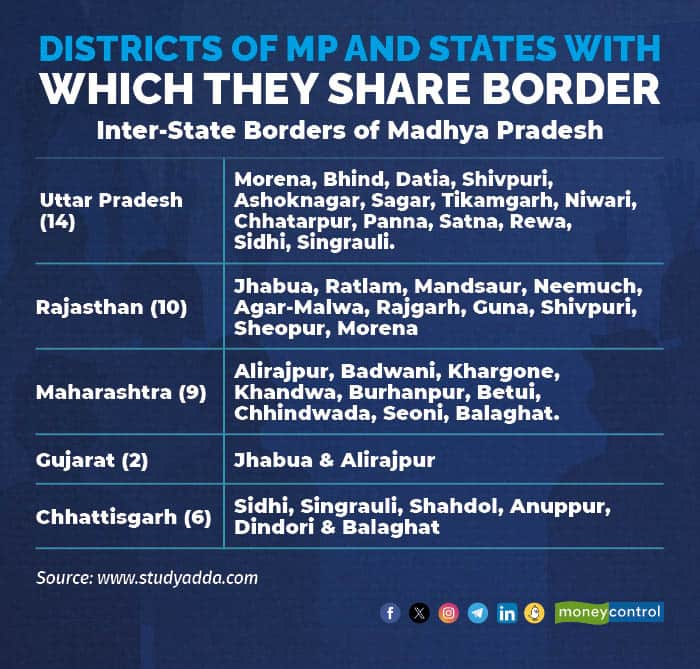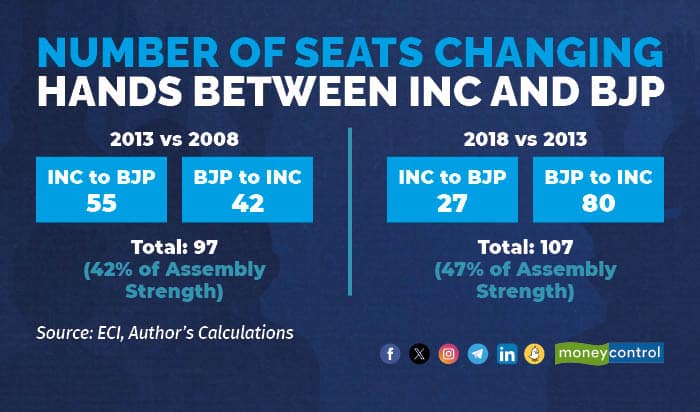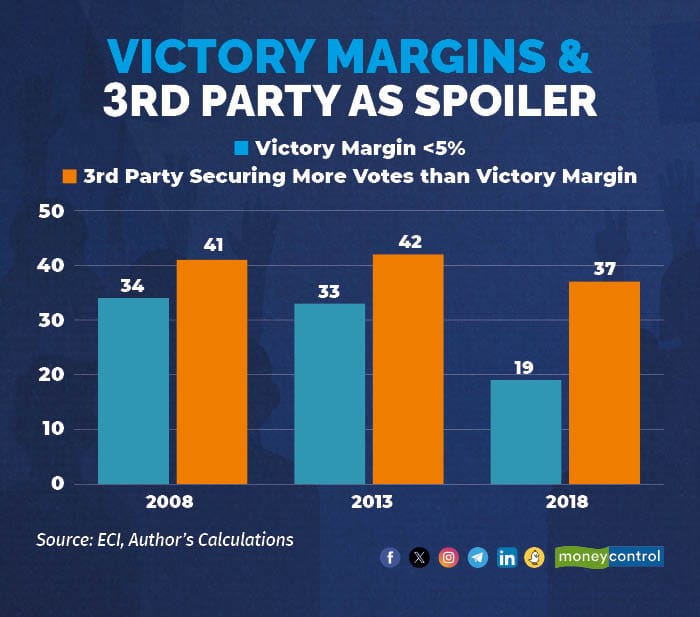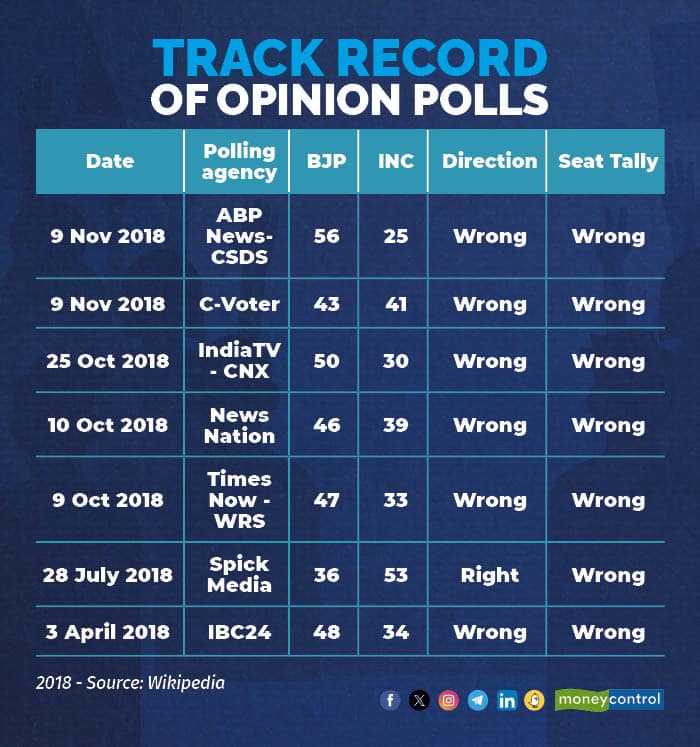



Madhya Pradesh (MP) votes today for all 230 seats in a single phase while Chhattisgarh for 70 seats in its second and final phase. A close contest is on the cards in MP with Shivraj Singh Chouhan and Kamal Nath locking horns. Allegations of kickbacks to Chief Minister Bhupesh Baghel in the Mahadev App case have boosted BJP’s flagging campaign in Chhattisgarh.
MP: Influence Of Neighbouring StatesMP shares borders with five states; Uttar Pradesh, Chhattisgarh, Maharashtra, Gujarat and Rajasthan. These states have social, economic and cultural influences on MP, including political and electoral. 34 of the 53 districts of MP share borders with one of the five states. Seven districts Morena, Balaghat, Shivpuri, Siddhi, Singrauli, Jhabua and Alirajpur share borders with 2 states.
Since Baghelkhand and Gwalior Chambal share a border with Uttar Pradesh, SP and BSP have a role to play here. BSP won two seats in 2018, both from these regions. In 55 seats, BSP recorded more votes than margin of victory, 47 of these were in Gwalior Chambal and Baghelkhand. On 28 of these it damaged the prospects of BJP and on 27 seats the Congress.
SP finished on the podium on 11 seats, 9 of them falling in this region. It damaged the prospects of Congress on 8 seats and BJP 2 seats, while winning 1 seat.


Congress hopes of making a comeback are pinned largely on the contest becoming bipolar and BSP-SP getting squeezed out in Chambal and Baghelkhand. C-Voter, which shows Congress ahead in MP, is predicting major gains for the party from these two zones.
Both parties have given tickets to rebels of Congress and BJP, thus making it a nail biting contest.
In Mahakaushal zone which shares a border with Maharashtra, in adjoining districts Balaghat and Chhindwara, BJP and Congress have put up candidates with surname Pawar and Kunbi caste in four seats each. Marwaris are an influential community in Malwa which shares a border with Rajasthan in the west.
MP: Trend Of Seats Changing HandsIn 2018 Congress had won 114 while BJP 109 seats in a house of 230. A tight contest on the anvil as suggested by surveys, which means the seat share and vote share gap could be very low – similar to 2018. A vote share gap of 5 percentage points could result in a sweep by either side.
PM Modi and Rahul Gandhi have been holding rallies and roadshows to lure the swing voter. BJP has launched a Rs. 24,000 crore scheme to woo the tribal voters while Congress is targeting farmers with loan waivers and bonus on paddy promises.

On more than 40 percent of the seats in MP, voters threw out the incumbent party / candidate. 97 seats changed hands even in 2013 when BJP retained the state, this increased to 107 in 2018 when it lost, highlighting the high level of local anti-incumbency.

BJP has replaced 32 while Congress has 11 of its sitting MLAs to neutralize this factor.
Chhattisgarh: BJP Banking On Mahadev AppIn Chhattisgarh, 14 seats of Northern and 56 of Central region are voting. In the 2018 elections, Congress had swept the Northern Surguja region winning all seats as the voters backed TS Singh Deo to be the CM if Congress came to power.
In the Central region BJP had won 13, Congress 37 and BSP-JCC alliance 6 seats. The Northern region touching Jharkhand is an ST belt with nine seats reserved for the community. BJP hopes to make some gains in this region on the back of extension of free ration distribution and announcements during Birsa Munda Jayanti celebrations in Jharkhand.
In the central region where the industrial, mining and urban centres lie, BJP hopes the alleged Rs 508 crore kickbacks to CM Bhupesh Baghel could influence a section of the neutral voters.
With the heat on him, Baghel on November 12 made a surprise announcement of Rs 15,000 annual financial assistance to women, bettering BJP’s manifesto promise of Rs 12,000. Chhattisgarh has a higher number of women voters than men (1.02 crore vs 1.01 crore) with a higher turnout (78.15 vs 75.7 percent). With women an x-factor in most states, Baghel didn’t want to take any chance it would seem.
Local Churn And High Anti-IncumbencyIn Chhattisgarh 60 percent of the seats in 2013 and 57 percent in 2018 changed hands between BJP and Congress.
In 2013, BJP retained power despite losing half of its sitting MLA seats (26/50), gaining a similar number of seats from the Congress. It won because of its better retention ratio (48 percent). In 2018, BJP lost almost 80 percent of its seats, while Congress displayed a better retention ratio (77 percent).

This shows a high level of dissatisfaction against local MLAs. Congress has denied tickets to 30% of its MLAs cognizant of this fact.
CG: Return To Norm Of Close Contests?The role of smaller parties like BSP, GGP, JCC, AAP etc. and independents is very important in the state as they could act as a spoiler for both parties.
On 37 seats the third party secured higher votes than margin of victory in 2018, the corresponding number for 2008 and 2013 was 41 and 42. On 19 seats the victory margins were less than 5 percentage points in 2018, while in 2008 and 2013, this happened on more than one-third of the seats.

Surveys suggest reversal to the mean, i.e., a close contest after a one-sided poll in 2018. However, Chhattisgarh is a nightmare for pollsters as most got it wrong in 2018 as shown below.

To sum up, for both Congress and BJP it is imperative to retain Chhattisgarh and MP as the results could create fresh narratives for 2024.
Amitabh Tiwari is a former corporate and investment banker-turned political strategist and commentator. Twitter: @politicalbaaba. Views are personal, and do not represent the stance of this publication.
Discover the latest Business News, Sensex, and Nifty updates. Obtain Personal Finance insights, tax queries, and expert opinions on Moneycontrol or download the Moneycontrol App to stay updated!
Find the best of Al News in one place, specially curated for you every weekend.
Stay on top of the latest tech trends and biggest startup news.